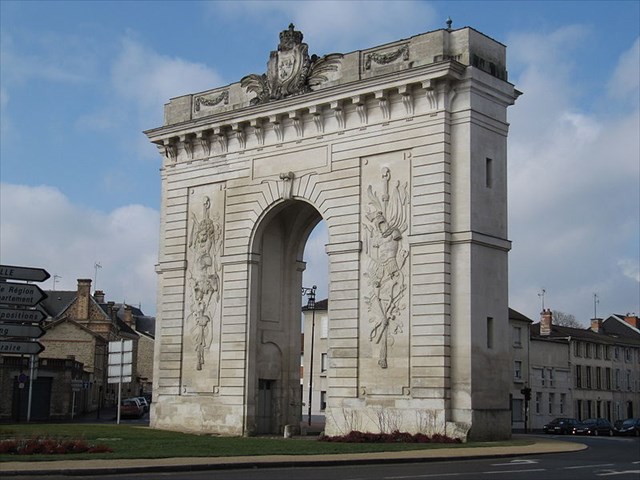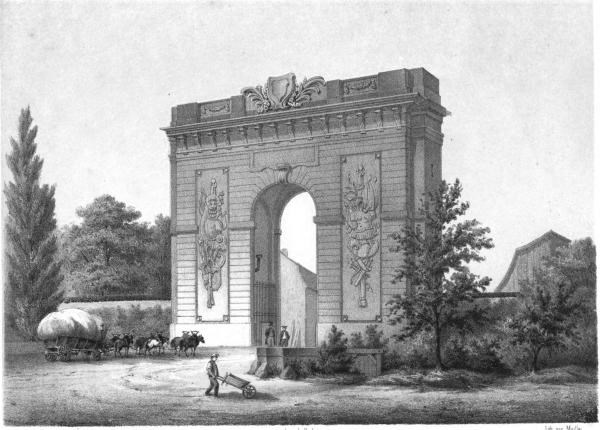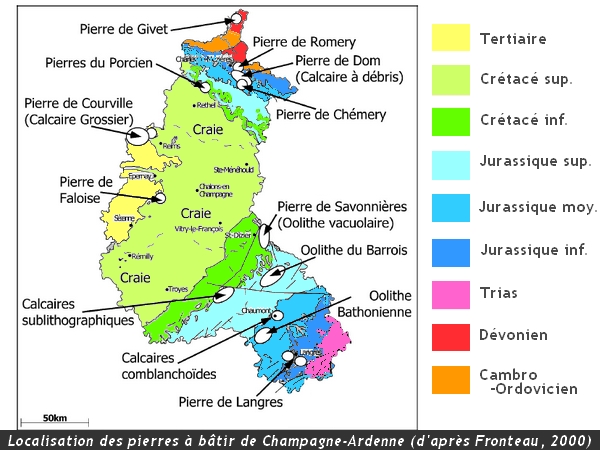La porte Savonnière
Histoire de la porte Sainte-Croix

La porte au XIIe siècle formait la limite de la ville fortifiée avec les faubourgs de Neufbourg. En 1536 elle est déplacé à l'emplacement des églises Sainte-Catherine et Sainte-Croix pour agrandir l'enceinte de la ville. L'intendant Nicolas d'Orfeuille embellissait la ville en rasant les anciennes fortifications et les cimetières Saint-Eloi et Sainte-Catherine en créant les espaces verts qui longent l'actuelle rue de Gaule. À cette occasion il fait appel à l'architecte Nicolas Durand pour édifier une nouvelle porte, c'est l'actuelle.

Également appelée Porte Dauphine elle a été dédiée en 1771 à Marie-Antoinette, à l'occasion de son arrivée en France pour son mariage avec le Dauphin, le futur roi Louis XVI. Seule la face Sud-Est, visible par Marie-Antoinette lors de son arrivée, est ornementée. Les sculptures sont l'œuvre d'Antoine Lépine.
Géologie : La pierre Savonnière
La pierre de Savonnières est un type de pierres utilisé dans la construction de nombreux bâtiments. C'est une pierre de calcaire oolithique vacuolaire et moins coquillier du Jurassique (l'étage Portlandien, 150-145 millions d'années).
La pierre de Savonnières est exploitée à Savonnières-en-Perthois et Brauvilliers dans le département de la Meuse (Lorraine).

Une légère teneur en oxyde de fer donne à la pierre une couleur blonde caractéristique du Barrois. Dans la vallée de la Saulx, la présence de cet oxyde ferreux donna lieu à une forte activité de fonderie.
D'un grain très fin et d'une grande facilité de taille, la pierre dite de Savonnières est en fait exploitée depuis des siècles pour l'édification et la sculpture.
Afin de valider cette Earthcache, il va vous falloir répondre à quelques questions, pour ce faire aller sur mon profil et envoyez-moi vos réponses.
Questions :
- De quel type est la pierre de savonnière ?
- Quel est l’aspect de la pierre de savonnière ?
- Qu’est ce qu’une vacuole ?
- Où peut-on trouver des pierres de Savonnières ? Et de quelle ère peut-on parler pour cette pierre ?
- Sur place grâce au spoiler, que pouvez-vous observez derrière les carrés rouge ? Que pouvez-vous me dire de cette observation ?
Une photo de vous devant la Porte jointe à votre log serait agréable, même si celle-ci n’est pas obligatoire.
History bears Holy Cross

The door to the twelfth century formed the boundary of the walled city with the suburbs of Neufbourg. In 1536 she moved to the location of churches St. Catherine and St. Croix to enlarge the city walls. The steward of Nicolas Orfeuille beautified the city hugging the ancient fortifications and cemeteries Saint-Eloi and St. Catherine by creating green spaces that run along the current street of Gaul. On this occasion he uses the architect Nicolas Durand to build a new door is present.

Also called Porte Dauphine it was dedicated in 1771 to Marie Antoinette, on the occasion of his arrival in France for his marriage to the Dauphin, the future King Louis XVI. Only the south-east face, visible by Marie Antoinette when she arrived, is ornamented. The sculptures are the work of Antoine Lépine.
Geology: The stone Savonnière
Savonnières stone is a type of stone used in the construction of many buildings. It is a limestone rock Oolitic vacuolar and less Jurassic shelly (Portlandian the floor, 150-145 million years ago).
Stone Savonnières operates in Savonnières-en-Perthois and Brauvilliers in the department of Meuse (Lorraine).

Mild iron oxide content gives the stone a blonde color characteristic of Barrois. In the Saulx valley, the presence of ferrous oxide that gave rise to a strong foundry business.
From a very fine grain and high ease of size, said stone Savonnières is actually exploited for centuries for building and sculpture.
To validate this Earthcache, you will have to answer some questions, to do this go to my profile send me your answers.
Questions :
- What kind of stone is soap dish?
- What aspect of soap dish stone?
- What is a vacuole?
- Where can we find stone Savonnières? And in what area can we talk to that stone?
- On site with the spoiler, what can you look behind the red square? What can you tell me of this observation?
A picture of you in front of the door attached to your log would, be nice even if it is not mandatory.
Bon geocaching!
